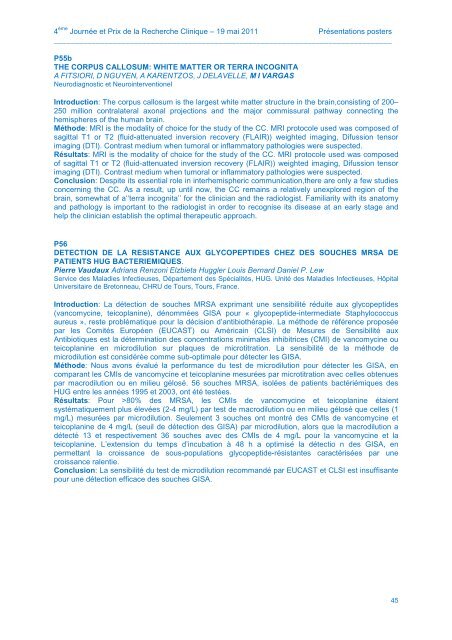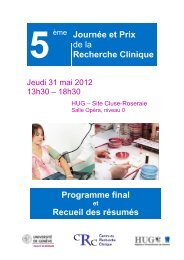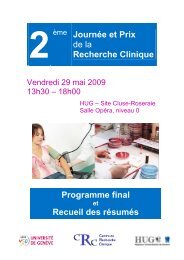Programme final et Recueil des résumés - Centre de recherche ...
Programme final et Recueil des résumés - Centre de recherche ...
Programme final et Recueil des résumés - Centre de recherche ...
Create successful ePaper yourself
Turn your PDF publications into a flip-book with our unique Google optimized e-Paper software.
4 ème Journée <strong>et</strong> Prix <strong>de</strong> la Recherche Clinique – 19 mai 2011 Présentations posters<br />
________________________________________________________________________________<br />
P55b<br />
THE CORPUS CALLOSUM: WHITE MATTER OR TERRA INCOGNITA<br />
A FITSIORI, D NGUYEN, A KARENTZOS, J DELAVELLE, M I VARGAS<br />
Neurodiagnostic <strong>et</strong> Neurointerventionel<br />
Introduction: The corpus callosum is the largest white matter structure in the brain,consisting of 200–<br />
250 million contralateral axonal projections and the major commissural pathway connecting the<br />
hemispheres of the human brain.<br />
Métho<strong>de</strong>: MRI is the modality of choice for the study of the CC. MRI protocole used was composed of<br />
sagittal T1 or T2 (fluid-attenuated inversion recovery (FLAIR)) weighted imaging, Difussion tensor<br />
imaging (DTI). Contrast medium when tumoral or inflammatory pathologies were suspected.<br />
Résultats: MRI is the modality of choice for the study of the CC. MRI protocole used was composed<br />
of sagittal T1 or T2 (fluid-attenuated inversion recovery (FLAIR)) weighted imaging, Difussion tensor<br />
imaging (DTI). Contrast medium when tumoral or inflammatory pathologies were suspected.<br />
Conclusion: Despite its essential role in interhemispheric communication,there are only a few studies<br />
concerning the CC. As a result, up until now, the CC remains a relatively unexplored region of the<br />
brain, somewhat of a‘‘terra incognita’’ for the clinician and the radiologist. Familiarity with its anatomy<br />
and pathology is important to the radiologist in or<strong>de</strong>r to recognise its disease at an early stage and<br />
help the clinician establish the optimal therapeutic approach.<br />
P56<br />
DETECTION DE LA RESISTANCE AUX GLYCOPEPTIDES CHEZ DES SOUCHES MRSA DE<br />
PATIENTS HUG BACTERIEMIQUES.<br />
Pierre Vaudaux Adriana Renzoni Elzbi<strong>et</strong>a Huggler Louis Bernard Daniel P. Lew<br />
Service <strong><strong>de</strong>s</strong> Maladies Infectieuses, Département <strong><strong>de</strong>s</strong> Spécialités, HUG. Unité <strong><strong>de</strong>s</strong> Maladies Infectieuses, Hôpital<br />
Universitaire <strong>de</strong> Br<strong>et</strong>onneau, CHRU <strong>de</strong> Tours, Tours, France.<br />
Introduction: La détection <strong>de</strong> souches MRSA exprimant une sensibilité réduite aux glycopepti<strong><strong>de</strong>s</strong><br />
(vancomycine, teicoplanine), dénommées GISA pour « glycopepti<strong>de</strong>-intermediate Staphylococcus<br />
aureus », reste problématique pour la décision d’antibiothérapie. La métho<strong>de</strong> <strong>de</strong> référence proposée<br />
par les Comités Européen (EUCAST) ou Américain (CLSI) <strong>de</strong> Mesures <strong>de</strong> Sensibilité aux<br />
Antibiotiques est la détermination <strong><strong>de</strong>s</strong> concentrations minimales inhibitrices (CMI) <strong>de</strong> vancomycine ou<br />
teicoplanine en microdilution sur plaques <strong>de</strong> microtitration. La sensibilité <strong>de</strong> la métho<strong>de</strong> <strong>de</strong><br />
microdilution est considérée comme sub-optimale pour détecter les GISA.<br />
Métho<strong>de</strong>: Nous avons évalué la performance du test <strong>de</strong> microdilution pour détecter les GISA, en<br />
comparant les CMIs <strong>de</strong> vancomycine <strong>et</strong> teicoplanine mesurées par microtitration avec celles obtenues<br />
par macrodilution ou en milieu gélosé. 56 souches MRSA, isolées <strong>de</strong> patients bactériémiques <strong><strong>de</strong>s</strong><br />
HUG entre les années 1995 <strong>et</strong> 2003, ont été testées.<br />
Résultats: Pour >80% <strong><strong>de</strong>s</strong> MRSA, les CMIs <strong>de</strong> vancomycine <strong>et</strong> teicoplanine étaient<br />
systématiquement plus élevées (2-4 mg/L) par test <strong>de</strong> macrodilution ou en milieu gélosé que celles (1<br />
mg/L) mesurées par microdilution. Seulement 3 souches ont montré <strong><strong>de</strong>s</strong> CMIs <strong>de</strong> vancomycine <strong>et</strong><br />
teicoplanine <strong>de</strong> 4 mg/L (seuil <strong>de</strong> détection <strong><strong>de</strong>s</strong> GISA) par microdilution, alors que la macrodilution a<br />
détecté 13 <strong>et</strong> respectivement 36 souches avec <strong><strong>de</strong>s</strong> CMIs <strong>de</strong> 4 mg/L pour la vancomycine <strong>et</strong> la<br />
teicoplanine. L’extension du temps d’incubation à 48 h a optimisé la détectio n <strong><strong>de</strong>s</strong> GISA, en<br />
perm<strong>et</strong>tant la croissance <strong>de</strong> sous-populations glycopepti<strong>de</strong>-résistantes caractérisées par une<br />
croissance ralentie.<br />
Conclusion: La sensibilité du test <strong>de</strong> microdilution recommandé par EUCAST <strong>et</strong> CLSI est insuffisante<br />
pour une détection efficace <strong><strong>de</strong>s</strong> souches GISA.<br />
45






